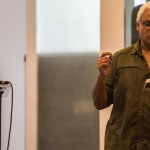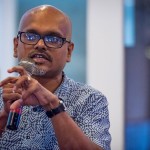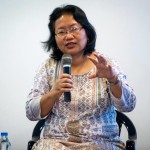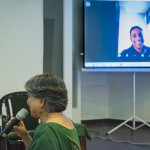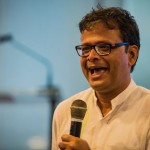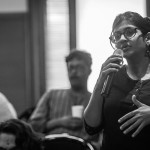Day 2: 16 August 2017
The second day began with an invigorating session titled ‘The Unequivalence of Violence: the Communal Question in Janam’s Plays’. Sudhanva Deshpande, editor, thespian, director and member of Jana Natya Manch (Janam) used various written and visual excerpts from Janam’s productions to talk about the evolution of communalism and the challenges of portraying violent narratives. He introduced the importance of the type of theatre, and the role of the audience, and the socio-cultural onus on actors in the artistic portrayal of the fraught terrain of violence. Using references and excerpts from Janam’s plays, including ‘Apharan Bhaichaare Ka’ (1986), ‘Hatyare’ (1978), ‘Yeh Dil Maange More, Guruji’ (2002), he discussed ‘theatre for social change’, which battles with gender, communalism and caste. Significantly, he mentioned how Janam has always been attacked, but in the current political scenario, it has become more difficult for them to be confident about how to express themselves. By enacting and performing (even singing) some of the excerpts, he kept the audience enthralled, introducing to them an alternative method into teaching history: the all-inclusive street play.
From plays, the question of history teaching moved to art. T. Sanathanan, the author of The Incomplete Thombu spoke on ‘How to Draw Histories? Art as a Method’. Sanathanan first contextualised history teaching in Sri Lanka, and traced it to Buddhism, state politics, and Sinhalese/Tamil conflict. He then spoke about his own negotiations with drawing objects in Sri Lanka and Vancouver to document conflict for his books, and finding stories of those affected by it along the way, thereby building a new narrative. He constructed another method into teaching: by using the object and art as a voice and testament to history, and engaging with it to understand conflict.
The third talk of the day, titled ‘The Camera as Witness’ focused on using photographs for history teaching. Joy Pachuau, professor of History from Jawaharlal Nehru University and Ryan Lobo, an award-winning filmmaker and photographer, used their own projects and experiences to talk about the subject. Joy Pachuau spoke about uncovering the silences of Mizoram through photographs and oral histories. By presenting and commenting on amateur, private and family photos, Pachuau created a cultural and social history of Mizoram. Ryan Lobo, who joined us over video call, looked at various communities and the images they document and create. He especially looked at the Bir Khalsa community, and their images of violence, and drew out cultural understandings. By mining this vast repository of visual evidence, which is, as Pachuau noted, ‘not normally taught to Historians’, a new method of perceiving history emerges which helps us look at life as lived.
The final talk of the day was titled ‘Bringing Marginalized Histories Alive through Literature’, and was given by Jerry Pinto. Pinto did not use the stage, choosing instead to pace before the audience, using anecdotes, humour, and ‘self-implication’ to record his experience as a biographer and translator. As a teacher, he integrated his own methods of questioning within the framework of his talk, and offered teaching methods, and more importantly, a renewed sense of vigour to teaching. His upfront, yet sensitive conversation about mental health, sexuality, caste and class left the audience buzzing, thinking, and looking forward to the final day of the conference.
– Anushka Halder and Stuti Pachisia
For more details about the speakers, click here.

